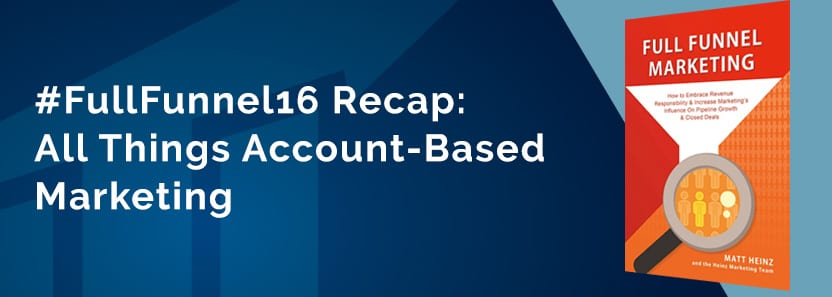This post, written by Maria Geokezas, originally appeared on the Heinz Marketing Blog.
If you couldn’t attend the Full-Funnel Marketing event held on June 16th in Seattle, here is a quick recap of the highlights.
Why #FullFunnel?
Megan Heuer, VP and Group Director at SiriusDecisions, kicked off the event by setting the foundation for a #FullFunnel approach to marketing. Calling herself a “marketing therapist,” she demonstrated how the role of marketing is expanding and that, as marketers, we have more opportunity than ever before to impact the entire sales funnel and beyond.
Yes, 67% of the buyer’s journey is done digitally. But that doesn’t mean sales is not involved at all stages of the buyer’s journey nor does it mean marketers can’t add value in accelerating the sale in later stages. Instead, marketing and sales “are both part of the solution at all stages of buying – in equal parts.”
So, how does #FullFunnel marketing impact growth of the business? Megan shared that growth can be stimulated by several different factors:
- Market conditions
- Competitive forces
- Processes
- Alignment between sales and marketing
This last factor accounts for 5-36% of the differences in performance and is the easiest to fix. Megan pointed out that companies whose marketing and sales organizations work together have 19% faster growth and 15% higher profits than companies where there is no alignment between the two groups.
Sounds pretty basic – we are more successful if we work together. So, why is it so hard? In one word – measurement. Bringing the marketing waterfall and sales pipeline together requires a change in the way executives look at their business. As a result:
- It forces sales and marketing to have the same plan.
- It makes it acceptable for sales to generate their own leads.
- It changes the definition of sales accepted leads.
- Marketing still gets credit for not directly generating leads.
The key to getting started for marketers is to share insight into how your prospects behave with sales. Make your process visible and start talking. This is an iterative process, and the more back-and-forth there is between the two groups, the faster your company will benefit from a #FullFunnel approach.
How Does Full-Funnel Work?
Jon Miller, CEO and founder of Engagio, followed Megan with a pragmatic perspective on how an account-based everything strategy supports the #FullFunnel approach. With only 15% penetration into target accounts, marketing working alone is not sufficient. The account-based everything strategy goes beyond marketing, to sales, sales development, and even customer success. Jon’s recommendation turns the traditional demand generation process on its head. Typically, demand generation starts with the offer, then goes to where to promote it, and last, to whom. An account-based process starts with the “who,” then the offer, and then where or how the message is delivered.
- Who – Targeting can be much more specific and meaningful. Instead of basic information like title, role, company, and industry, you can become more intimate with your prospects and gain more valuable insights into what they are working on, key initiatives, role in decision-making and more. Plus, it’s aligned between the different departments so that both sales, marketing, and customer success can utilize the information in a coordinated fashion.
- What – If you know more about your prospect, the “what” of your message should be relatively straightforward. Jon cited that 75% of executives will respond to unsolicited outreach if the ideas presented are relevant to their industry or business or if the sender present new ideas in a thought-provoking manner.
- Where – The channels used for outreach should be integrated among the players within the marketing, sales, and executive ranks as well as the different channels used — from marketing efforts like personalized online advertising and direct mail to sales channels like email, calling, and social.
The account-centric effort brings the message and channel together in a highly coordinated play vertically throughout the organization.
Metrics differ from traditional marketing metrics. Instead, account-centric reporting should include the following metrics:
- Coverage – Access the right personas in the target accounts.
- Awareness – The right personas know who you are.
- Engagement – They demonstrate increasing engagement over time.
Jon closed his talk at #FullFunnel16 by saying that the most challenging issue facing organizations today that want to adopt an account-centric strategy is matching leads to accounts. And how this impacts how progress is tracked and success is measured.
Full-Funnel Advice
Finally, our panel of experts discussed what #FullFunnel marketing means to them and their organizations.
Sangram Vajre from Terminus emphasized the most important difference between #FullFunnel marketing and traditional lead generation is knowing exactly who you are going after.
Christine Vermes from Full Circle Insights highlighted how the full-funnel perspective allows you to measure the entire funnel. That includes not only volume, but the quality of the funnel and marketing’s direct impact to revenue.
Emily Wingrove from Social123 stressed the importance of knowing your audience and developing a robust database to inform your full-funnel strategy.
Michael Korch from Qumulo provided an example of how the #FullFunnel approach can be used as a forcing function that brings marketing and sales teams to work together to work toward a common goal. He thinks of his marketing department as the “make sales easier” department.

The importance of marketing and sales alignment was reiterated throughout the different presentations and speakers. And afterwards, during the networking cocktail hour, audience members continued the discussion sharing their own experiences.

Want More About Account-Based Marketing?
Account-Based Marketing for Dummies, written by Terminus CMO and Co-Founder, Sangram Vajre, has an abundance of information useful for any level of education in account-based marketing. Click here to download the first chapter for free and take the plunge into #ABM.
